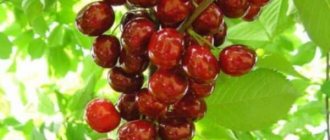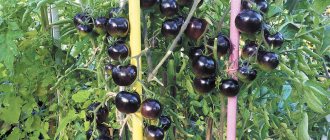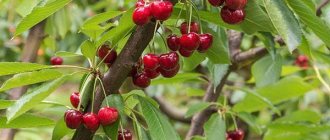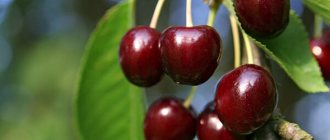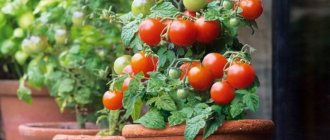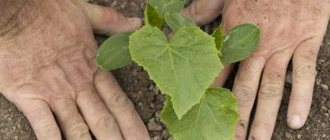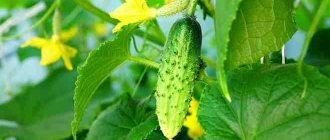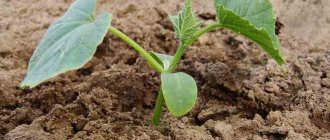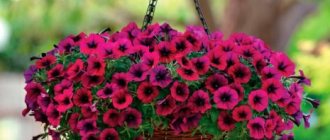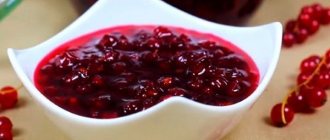Among the many varieties of fruit trees, there are also those whose origin is not known for certain. These include the Daibera black cherry, which received its name in honor of its author, the gardener A. Daibera. He discovered this variety as an accidental seedling in the Crimean Gurzuf. This was back in 1862. Inclusion in the State Register of Selection Achievements of the Russian Federation took place only in 1947. The regions allowed for cultivation were the North Caucasus (Republics of North Ossetia-Alania, Karachay-Cherkessia, Ingushetia, Chechen Republic, Rostov Region and Stavropol Territory) and Lower Volga (Republic of Kalmykia). The originator is the North Caucasus Federal Scientific Center for Horticulture, Viticulture and Winemaking. The plant is also known under other names: South Coast, South Coast Red, Bigarro Daibera.
Description of culture
Daibera Black cherry is a large-fruited variety and produces berries weighing 6-7 g. The shape is wide-heart-shaped, slightly tuberous. The seam is clearly visible. The skin color is dark red, almost black. The pulp of the fruit is dark, rich red in color, tender when ripe, and has an excellent dessert sweet taste with a light, barely noticeable sourness.
The pulp is characterized by medium juiciness, the juice is bright red in color. The fruit seed is large, difficult to separate from the pulp, weighs about 0.45 g and accounts for 7% of the total mass of the berry. The stalk is 40 mm long, wide, and easily separated from the fruit.
The Daibera Black cherry tree is tall and growing vigorously. Its height can reach 6 m. Young shoots are straight, greenish-brown, form inflorescences of 2-3 flowers. The wide-rounded crown of this tree is distinguished by branching branches and strong foliage. The leaf is oval-elongated, with a sharp end.
Important! The southern regions of the country and areas with a warm, favorable climate and mild winters are suitable for growing Daibera Black cherries. In rainy and cold parts of the country, this cherry tree does not take root, is affected by diseases and bears little fruit.
The main diseases of cherries
Cherry fruits can be affected by fruit rot, and concentric round growths appear on them.
Hole spot creates holes in the leaves and they die.
Gum flow leads to drying of young shoots.
Scab appears as bright yellow spots on leaves and fruits.
To combat these diseases, you need to select fungicides - sulfur color, Bordeaux mixture and others.
Characteristics
Below are the characteristics of the Daibera Chernaya cherry variety as an assessment of the most important indicators of the crop.
Drought resistance, winter hardiness
Cherry is a moisture-loving crop, and the Daibera Black variety is no exception. During a sustained period of drought, it is necessary to increase the frequency of watering.
Daiber Black cherry is not characterized by increased frost resistance - at temperatures below -30 0C there is serious freezing of shoots, branches, and trunk, and at -24 0C almost all flower buds are damaged.
Pollination, flowering period and ripening time
Depending on the region in which the summer cottage is located, the shoots of the Daibera Black cherry are covered with large white flowers in late March - early April. During the flowering period, the plant looks very decorative. Daibera Black cherry is self-sterile, so to obtain a high yield it is necessary to plant one of the pollinating varieties.
Advice! The best pollinators of the variety are Jaboulet, Ramon Oliva, Hedelfinger. When planting the Black Eagle, Francis, and Zolotaya varieties, good yields of Daibera Black cherries are also observed.
In terms of ripening time, this variety is classified as mid-late - the fruits can be harvested in late June - early July.
Productivity, fruiting
The impressive size of the tree and the size of the berries ensure its high yield. This indicator depends on the growing region and the age of the plant. Adult specimens are the most productive - 70-90 kg of berries can be collected from one tree. The Daibera Black cherry begins to bear fruit in the fifth year after planting the seedling.
Area of application of berries
The berries of this variety of cherries are consumed mainly fresh. But they are also suitable for processing: you can make delicious compotes and jams from the fruits.
Resistance to diseases and pests
The Daibera Black cherry variety has average resistance to diseases, so it is important to carry out preventive measures annually for protection. Since this cherry belongs to quite old varieties, it is often affected by coccomycosis, moniliosis (fruit rot), and clasterosporia (hole spot). Especially great damage is caused to the Daiber Black cherry during rainy springs.
Advantages and disadvantages
Analyzing the above characteristics of Daibera Black cherries, we can highlight a number of its advantages and disadvantages.
The advantages of the variety include:
- high and reliable yield indicator;
- size and dessert taste of berries;
- the benefits and versatility of eating fruits;
- decorative flowering;
- friendly return of the harvest.
Cons of Daibera Black cherries:
- average winter hardiness, due to which the plant can be grown in regions with mild winters;
- poor resistance to common crop diseases;
- limited time for harvesting fruits; if harvested too late, they are affected by gray rot.
About Daibera cherries: description and characteristics of the variety, planting, care, cultivation
Daiber black cherry is an excellent variety, which is considered one of the oldest and most popular in horticulture. Its difference from many other plantings is that cherries produce an incredibly abundant and high-quality harvest, which does not become smaller even under the influence of some negative external factors.
If the gardener is familiar with some of the features and subtleties of planting Daibera black cherries, then he will be able to achieve a truly excellent result. It is very important to understand where this variety came to us, what its features are, how to plant plants correctly and care for them in such a way that the plantings are protected from pests and common diseases.
Growing
Cherry is very thermophilic. More recently, its range covered exclusively the southern regions. But through the efforts of breeders, varieties appeared that took root in the middle zone. It is very important to protect the plant from cold winds. The optimal solution is a small hill.
When growing Cherries, do not forget that most varieties are self-sterile. Therefore, to obtain a harvest, you need to have at least two different varieties planted not far from each other.
Cherry branches grow quickly. Every spring it is necessary to carry out formative pruning. Up to a fifth of the shoot is removed. Mature trees branch weakly. However, sanitary pruning of broken and dried branches is still the responsibility of the owner. Sections should be cleaned and treated with garden varnish.
Landing Features
In order for a crop to produce high yields, it is necessary to plant it correctly, taking into account the timing, location, planting rules, and also choose the appropriate planting material.
Recommended timing
Cherry seedlings are planted in the spring, when the soil has thawed and warmed up sufficiently, and return frosts will be behind. If you purchase a tree in the fall, you can bury it at an angle of 450, and plant it in a permanent place in the spring. In the southern regions, Daibera Black can be planted in the fall.
Choosing a suitable location
Sweet cherries grow well and bear fruit in rich, nutritious soils with a light structure, and the tree should be placed in a well-lit, sunny place where there are no strong cold winds. The roots of the tree reach a depth of 2 m, so it is not planted in a place with high groundwater levels.
What crops can and cannot be planted next to cherries?
Sweet cherries and cherries go well together and somewhat increase each other’s yield. In addition, the following types of crops can be planted near them:
- grape;
- hawthorn;
- Rowan;
- elderberry (protects against aphids);
- honeysuckle.
It is not recommended to plant next to cherries:
- nightshade crops;
- some trees: linden, oaks, birches, maples;
- some fruit bushes: raspberries, gooseberries, sea buckthorn, currants.
Advice! The trunk circle of the Daiber Black cherry can be decorated with flower ground cover crops or low shade-tolerant flowers.
Selection and preparation of planting material
When purchasing a Daibera Black cherry seedling, you need to carefully evaluate its appearance. First of all, its height must correspond to its age: for one-year-old specimens - 70-80 cm, for two-year-old specimens - about 1 m. You should pay attention to the state of the grafting. It should be dense, without damage or leakage. The bark of the tree over its entire surface should look healthy; if traces of pests and diseases are noticed, it is better to refuse the purchase.
Important! Immediately before planting, the roots of the seedling are soaked in water for 2 hours. If the root system is dry, then for 10 hours.
You can learn more about choosing a cherry seedling from the video:
Landing algorithm
For planting, you need to dig a hole measuring 80 × 80 cm. A layer of sand is laid at the bottom for drainage if the soil in the area is heavy, and clay if it is light. It is necessary to immediately install a support for the cherry tree. Next, add a nutrient mixture, which includes: 2 buckets of soil, 3 kg of superphosphate, 1 liter of ash, 1 kg of potassium fertilizer, 35 kg of humus, 2 kg of ammonium sulfate.
In the center of the planting hole you need to make a low mound, place the cherry on it, carefully straighten its roots and tie it to a support peg. Then, when adding soil, it is lightly compacted so that no air cavities are formed. A seedling is planted correctly if its root collar is at least 3 cm from the surface of the ground.
Mulching the tree trunk circle is carried out after abundant watering. You can use humus, peat, old leaves or sawdust as mulch.
The scheme for planting several cherry trees for pollination requires maintaining a distance of 3-5 m between them.
Cherry common 'Shakirovskaya'
Main species: Common cherry
| Fruit size |
| Fruit shape |
| Fruit color |
| Winter hardiness |
| Decoration of plants and fruits |
| Flower size |
| Brush characteristics |
| Berry/truss separation |
| Nut kernel size |
| Blush (cover color) |
| Fruit pulp color |
| Density and character of the pulp (fruit/bush/yag) |
| Fruit aroma |
| Frost resistance (fruit/bush/yag) |
| Drought resistance (fruit/bush/yag) |
| Beginning of fruiting after planting |
| Ripening period (fruit/bush/yar) |
| Consumer maturity |
| Productivity (fruit/bush/yag) |
| Fruit shedding |
| Remontant |
| Self-pollinating/self-fertile |
| Purpose of fruits (fruit/bush/yag) |
| Taste of fruits (fruit/bush/yag) |
| Soil pH requirements (fruit/bush/yag) |
| Shelter for the winter (fruit/bush/yag) |
| Soil type (fruit/bush/yar) |
| Disease resistance (fruit/bush/yag) |
| Resistance to pests (fruit/bush/yag) |
| Habitus (fruit/bush/yag) |
| Growth form |
| Crown density |
| Thorns, thorns |
| Vitamin content (fruit/bush/yag) |
| Keeping quality of fruits (fruit/bush/yag) |
| Cultivation region by origin (fruit/bush/yar) |
Expand all properties
Description of the plant:
Common cherry 'Shakirovskaya' is the result of pollination of the 'Shchedraya' variety with a mixture of pollen from the 'Zaravskaya' and 'Large-fruited No. 6' varieties. Obtained from the Tatar Research Institute of Agriculture. At state variety testing since 1993. Authors: L.A. Sevastyanova, V.A. Naumov.
The variety was included in the state register in 1997 in the Middle Volga (Republic of Tatarstan) and Ural regions.
Dimensions and growth form:
Common cherry 'Shakirovskaya' is a bush with a flat-round crown and drooping branches.
Flowers and fruits:
The fruits are above average size, 4.1 g, round-oval, dark red.
The pulp is relatively dense, red, juicy. The taste is sweet and sour, good.
Precocity, ripening time, yield:
Cherry's precociousness is assessed as average. The variety is universal, highly self-fertile. Differs in good rooting of cuttings. Mid-early ripening. Productivity is above average.
Disease resistance:
Common cherry 'Shakirovskaya' is moderately resistant to coccomycosis.
Subsequent care of the crop
Daibera Black needs basic care throughout its entire life cycle.
In the spring, before the start of sap flow and swelling of the buds, the crown of the Daibera Black cherry is formed. This culture is formed in 2 tiers: about 8-9 skeletal branches are left on the first, 2-3 layers are left on the second. The central stem of the plant in adulthood is cut at a height of 3.5 m - this helps limit the growth of the tree. Also in the spring, sanitary pruning is carried out - removing all damaged and frozen branches to the ring.
Preparation for winter involves watering the tree in the fall and whitewashing its trunk and thick branches. Young Daibera Black cherries are wrapped in spruce branches.
Watering and fertilizing are inseparable when growing Daibera Black cherries. If the weather is favorable, this crop needs only 3-4 abundant waterings per season, so they are carried out simultaneously with root feeding. Slurry (proportion 1:8), complex fruit and berry fertilizers, and ash infusion (ratio with water 1:10) are used as fertilizers. In the spring, Daibera Black cherries are fertilized with urea, scattering 60-80 g of dry granules.
Important! All fertilizing must be applied according to the diameter of the crown - this is where the bulk of the sucking roots lie underground. There are no such roots near the tree trunk.
There are different ways to protect fruit crops from rodents: wrapping trunks with nylon, mesh, roofing material, branches of coniferous plants, as well as trampling snow in winter.
Gardeners' opinions about Daiber
Olga M. Stavropol
I have been growing Daibera for a long time. It amazes with the size and weight of the berries. It grows well in our area, sometimes I harvest up to 20 buckets of the crop. The berries are very tasty, the fleshy ones can be used to create real culinary masterpieces.
Alena, high school student. Belgorod region
In our family, my grandmother takes care of the garden. Her favorite trees are cherries; she has many varieties of them in different colors. My favorite is the Daibera black cherry. It has a pleasant taste, and the berries themselves are very large. And the jam made from this cherry is the most delicious.
Vitoshkin Petr Sergeevich, experienced gardener and gardener. Volgograd region
Taking care of the garden is my hobby and at the same time a source of income. For myself, I came up with a theorem that it is most profitable for the market to grow cherries. Every year I place my main hopes on Daibera cherries; they bear fruit consistently and provide income.
You just need to work with her seriously throughout the season.
Diseases and pests, methods of control and prevention
For clarity, possible diseases and pests of Daibera Black cherries are collected in tables indicating preventive and treatment measures.
Table 1 - Pests
| Pest | Preventive measures | Control measures |
| Black cherry aphid | Ensuring proper care of cherries, timely application of fertilizers Correct pruning of affected shoots: it is necessary to capture at least another 10 cm of healthy tissue. Timely collection of all trimmed parts and their burning. Spring and autumn whitewashing of the trunk | Chemicals: Actellik, Intavir. Folk remedies are effective only when the pest population is small: repellent infusions of tobacco, dandelion, green onions |
| Moth | Spring spraying of the tree with Chlorophos, Karbofos, and other insecticides before buds open | |
| Weevil | Chemicals: Intavir, Karbofos, Rovikurt |
Table 2 - Common diseases
| Disease | Signs of the disease | Control measures |
| Coccomycosis | The appearance of initially small, red-brown spots on the foliage that eventually increase in size, while a pinkish-gray coating develops on the underside of the leaves - fungal spores. The leaves curl and fall | Treatment with fungicides containing copper during swelling of the buds: Bordeaux mixture, Kuproksat, Abiga-pik, copper oxychloride solution 0.3%. During the flowering period - spraying with “Horus” (3 g per bucket of water). During fruiting - “Skorom” (ampoule in a bucket of water). After harvesting - treatment with Bordeaux mixture of 1% concentration |
| Moniliosis | Drying of leaves, drying of flowers, drying of unripe fruits, blackening of branches. The tree looks burnt - the places where the fungus has colonized turn black | |
| Clusterosporiasis | The disease appears on the foliage, which becomes covered with reddish spots. Over time, they grow; in the center of each of them, the tissue becomes dead and falls out, forming holes with a red border. Over time, the disease spreads to the shoots and fruits, forming ulcers from which juice flows |
History of the variety
This variety of cherry was not specially bred, but appeared due to accidental pollination. The homeland of the black cherry variety Daibera is Crimea. The official date of birth of the culture is considered to be 1862. The culture was named after the gardener who first discovered the variety and compiled its detailed description. This variety of cherries was included in the State Register after the war in the late 1940s.
Cherries were zoned in the North Caucasus and in the Lower Volga region. The official name of the variety is A. Daibera Black cherry, but people often use the abbreviated names Daibera, Black. Sometimes this variety is called Crimean cherry.
Frost resistance
This garden tree does not tolerate frost very well, so it is not suitable for growing in the northern regions of Russia. When frost reaches −24°C, all flower buds die. If the temperature drops below −30°C, the branches, trunk and shoots of the cherry tree freeze. Irreversible changes occur, they turn black and die.
Important! In addition to low frost resistance, the crop does not tolerate drought well. In order for the plant to bear fruit well in dry summers, intensive watering is necessary.
Productivity
Daibera cherry is a large tree with a spreading crown, the berries are large, so the yield is high. The younger the plant, the greater the yield and vice versa.
Important! In the southern regions, more berries are harvested from one tree than from those planted in the northern regions. With proper cultivation techniques, up to 90 kg of fruit can be harvested from one tree per season.
The plant begins to bear fruit 4 years after the seedling has been planted in open ground. The variety belongs to the mid-season, the berries begin to ripen in the third ten days of June - the first ten days of July
With proper cultivation techniques, up to 90 kg of fruit can be harvested from one tree per season. The plant begins to bear fruit 4 years after the seedling has been planted in open ground. The variety belongs to the mid-season, the berries begin to ripen in the third ten days of June - the first ten days of July.
Tree options
You can recognize Daibera cherries by the following characteristics:
- tree height up to 6 m,
- fruit weight 6-7 g,
- the taste of the berries is pronounced, sweet with a slight hint of acid,
- fruit color is dark burgundy, close to black,
- straight shoots of brown-green color with inflorescences, each of which has 2-3 flowers,
- crown shape is round, wide,
- The shape of the leaves is oval, slightly elongated, pointed.
The crown of the tree is branched, each shoot contains a large number of leaves.
Flowering begins in the last ten days of March (in the southern regions) or in the first ten days of April (in more northern regions). The plant is covered with a large number of large white flowers. This is a self-fertile crop, therefore, in order to get a lot of berries, you need to plant pollinating varieties on the site. The following varieties of cherries are suitable for this purpose:
Important! You can plant one variety as a pollinator, or you can plant several at once. This is interesting: How to plant beets with seeds in spring - useful tips from agronomists
This is interesting: How to plant beets with seeds in spring - useful tips from agronomists

